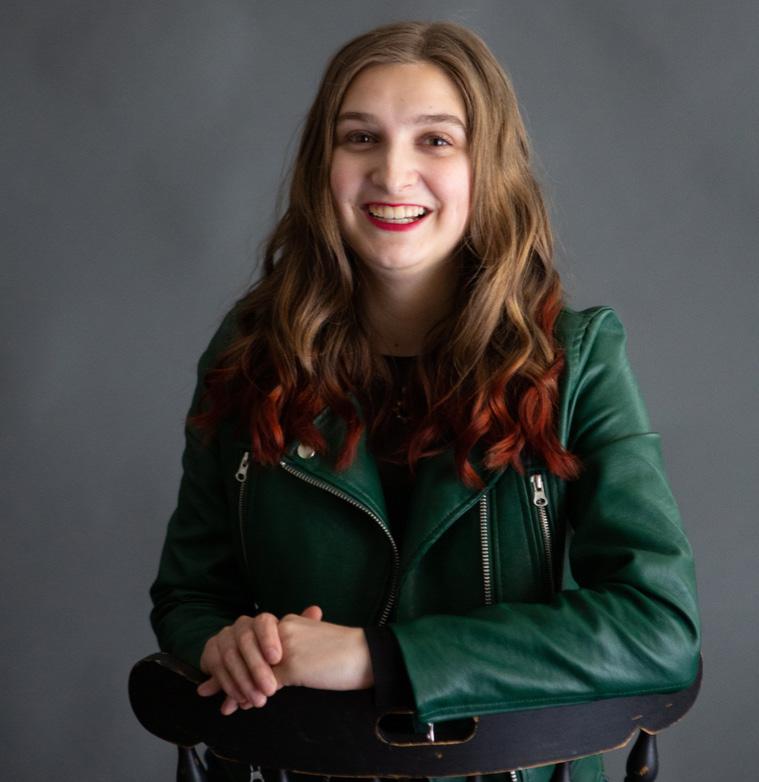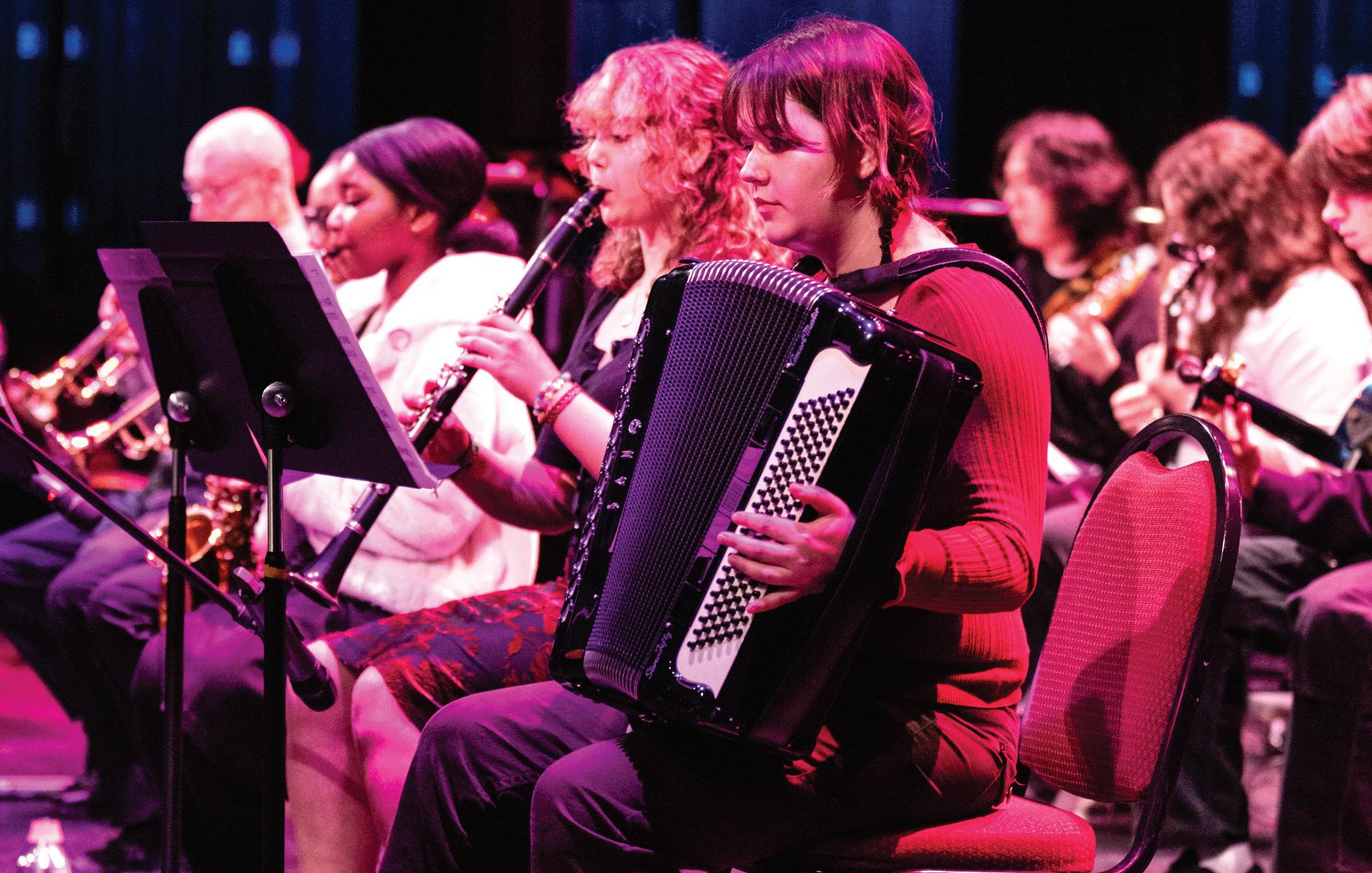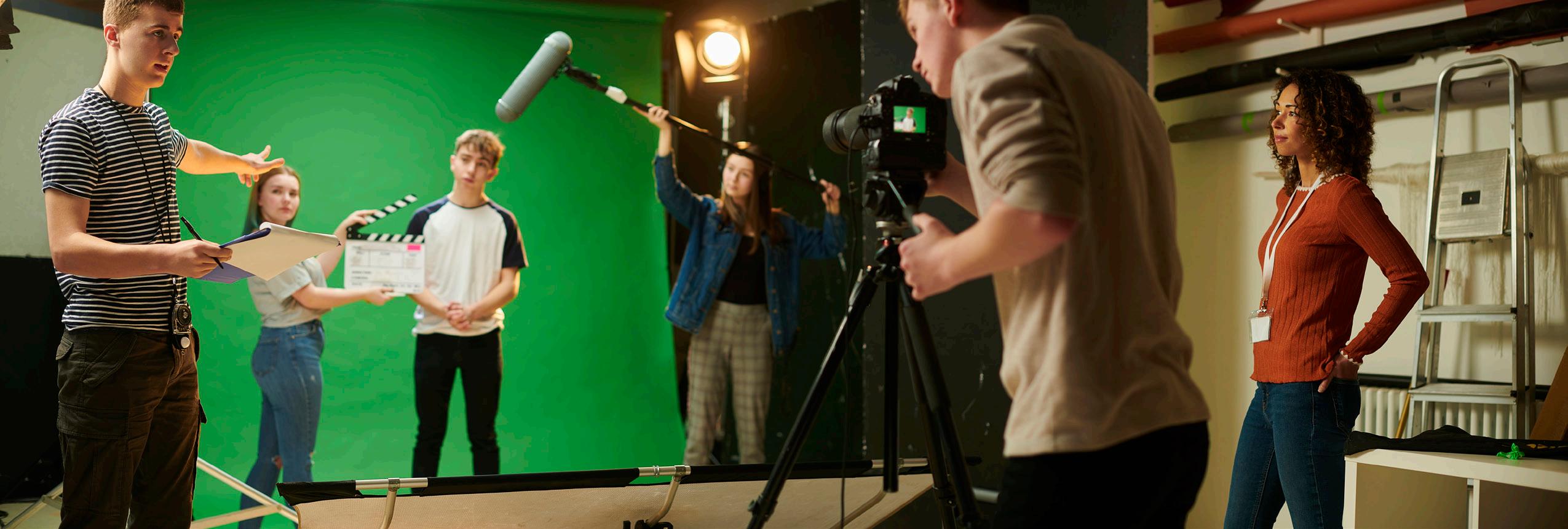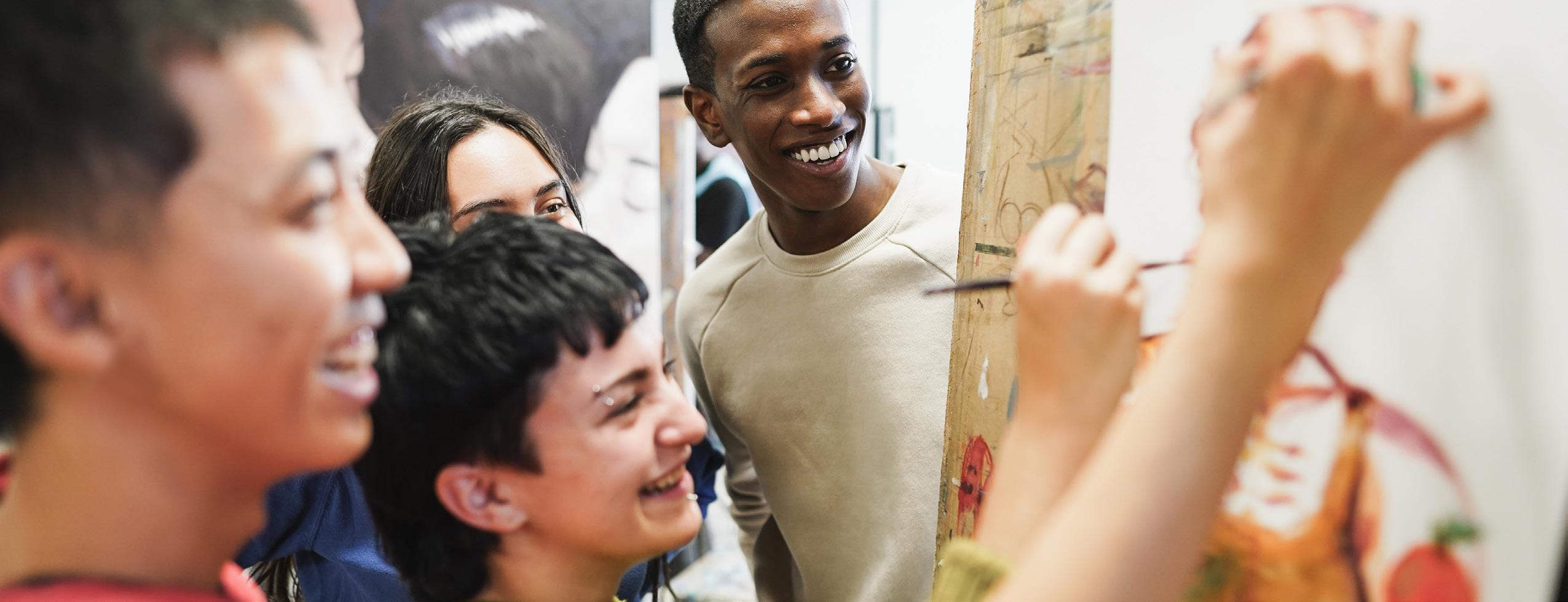





Parsons Summer Intensives: Art, Fashion, and Design
Study alongside like-minded creatives at Parsons, a globally top-ranked design school. Attend a three-week program at our vibrant New York City campus where you’ll learn from faculty who are leaders in their fields and engage with fellow students who share your passion for fashion, art, and design. Build your creative portfolio—all while earning three college credits!

June and July sessions
Learn more at cpe.newschool.edu/summer

FOUNDER & CEO
Marie Schwartz mschwartz@teenlife.com
EDITOR
Emily Rohozen emily@teenlife.com
ADVERTISING SALES
Brenda Boos brenda@teenlife.com
Jen Fisher jen@teenlife.com
Regan Beiermann regan@teenlife.com


To download a PDF of this guide, go to: www.teenlife.com/your-future-in-arts


aying the words, “I am an artist” brings a certain sense of pride. With that statement, you can be referring to one or more of the many ways of expressing art. As an artist, you can choose to pursue that career path into adulthood or engage in the arts alongside a complementary career path. Either way, the arts will enrich your life in the years ahead.
Are you wondering how an arts degree can help you? We will tell you. Would you like to apply to an arts school, but don’t know the details? We are here to help you with that. Whether you are interested in being a choreographer, fashion designer, actor, or professional musician, an arts degree that caters to your interests exists in many colleges and universities, both in the US and abroad. Majoring in the arts brings its own challenges, but those challenges can also be a starting point for something big. If you are not sure if you want to major or minor in the arts in college, we encourage you to dip your toe into the water by attending a summer program focused on the arts.

QUESTIONS OR SUGGESTIONS?
Email me at mschwartz@teenlife.com

Welcome to “Your Future in Arts!” This digital guide is one in a series that strives to help students learn more about careers in specific career clusters, as well as the best ways to prepare themselves during high school for the competitive application process ahead! Please let us know if you have any questions or suggestions to make this resource as helpful as possible.


Experience college life during the summer and jumpstart your fashion career with Polimoda’s Pre-College programs. Immerse yourself in the fashion world through hands-on learning and industry-led courses, visits to fashion museums, companies and productions, and unique field trips.
Our extensive course offerings cater to every fashion discipline.
 By Marti Buckley
By Marti Buckley
he practical parent questioning the idealistic teenager’s degree choice is a tale as old as time. Often a well-meaning parent’s advice is to be sensible, think about job security and pursue a degree that has an obviously mapped-out career path. However, in a world where the economic climate is more uncertain than ever and artificial intelligence is changing human roles in the workforce, traditional advice often leads to a dead end. The arts degree, however, continues to offer benefits that can be even more sought after in the 21st century.
The first step of understanding the value of an arts degree is dismantling the stereotype of the starving artist. Not a difficult feat when you dive into the research on the subject — according to a study by Georgetown University, degrees from top liberal arts colleges pay off just as much as degrees from big research universities in the long run.
It’s not just about the bottom line, though. An arts degree isn’t just about getting a job; it’s about becoming a well-rounded human. Arts degrees build a strong foundation, sculpting critical thinking skills that help you untangle any problem, research like a pro and express yourself with clarity. The college experience with an arts degree is also often superior — think intimate-classroom settings and collaborative learning over packed classes with a professor you’ll never meet.
You’ll explore different cultures, develop empathy and gain a unique perspective that sets you apart. Whether you’re a future CEO, social- justice warrior or tech whiz, an arts degree equips you with the critical thinking, creativity and communication skills you need to thrive in a rapidly changing job force.
Everyone goes to college with an eye toward preparing for their career. The secret that no one tells you, however, is that you learn much more than how to join the workforce as you make your way from the 101s all the way to advanced senior-level courses. Arts degrees are the basis of a strong foundation that can be built upon both during your college career and after. They allow (and demand) students to develop the rigorous discipline necessary for adhering to project timelines and adopting the skills and processes necessary to make their ideas and visions take shape.
Not only does this discipline help meet deadlines, but it also prepares individuals for future challenges, more so than the linear structure of traditional subject learning. The researchintensive nature of arts programs also molds students with strong analytical and critical-thinking skills. From the first day of class, art students are researching and taking into account historical sources before synthesizing them into their own work. These research skills are highly transferable to many
career paths. That’s not the only foundational (and transferable) skill that students learn on their way to an arts degree, though.
“Summed up, the one transferable skill for me would be ‘know thyself’,” said Julian Zabalbeascoa, associate director of Honors Experiential Learning Opportunities and Communication at Lowell Honors College at the University of Massachusetts. “An invaluable skill for work, but more importantly for life. The arts, along with the creation and study of them, are what can get you there.”
The typical student spends at least four years in undergraduate, with an average tuition cost of $19,806 per year. Students and parents normally have their eyes on future ROI as it relates to the job market, but let’s be honest — for that amount of money, the college experience should be fabulous. This is another area in which an arts degree shines.
Arts courses and classes often foster an incredibly close-knit community, thanks to the intimate setting and smaller class sizes. You won’t find much amphitheater anonymity here — instead, you’ll find engaged students in small classes receiving lots of personalized attention. Not only does this make for happier students, but it also encourages collaboration and teamwork, an invaluable preparation for the real world.
Nelson Mandela famously said, “Education is the most powerful weapon which you can use to change the world.”
Higher education helps teenagers transition into adults, and an arts degree is especially effective in molding them into humans who can think critically and creatively. Arts education is known for fostering critical thinking, analytical skills and the ability to interpret complex information. Studies suggest these skills are highly transferable to various professional fields, along with the adaptability and flexibility that go hand-in-hand with an interdisciplinary learning environment. That adaptability that this type of learning fosters is a major asset in today’s job market.
Creativity and innovation are two other hallmarks of an art degree. They are also skills that are increasingly recognized as essential, in sectors from technology to health care. Add to that the communication and collaboration that arts programs foment among their majors, and you get a package of skills that could be crucial in any workplace.
Think artists have no career prospects? Think again. The studies show that once arts graduates settle into a chosen career path, they achieve career success and job satisfaction comparable to graduates from other disciplines. The diversity from which they have to choose, by the way, is unparalleled — art majors meet with success everywhere, in fields ranging from advertising, design, education, marketing, media and technology.
Don’t believe it? Drop the stereotypes and take a look at the numbers. Creative higher education performs as well or better than many other specific subjects on multiple measures. When controlling for socioeconomic factors, there is no statistical difference in the effect on average earnings of those who study a creative subject and those who pursue degrees in biology, languages or psychology.
“The assumed viability or nonviability of a degree should, ideally, not be the determining factor for a student,” said Zabalbeascoa. “The American economy does not seem to be in harmony with the society it should be in service to. Your life is yours and, hopefully, it is long. What a shame then to allow a manipulated and skewered economy to dictate the way in which you will spend the majority of your working life.”
The wide range of career options available to arts graduates makes an art degree extremely attractive. While the job market may feel challenging — nowadays, it is for everyone — changes in technology, such as the advent of artificial intelligence, make for creative, visionary thinking that arts majors learn as an invaluable career skill. The demand for creative skills can only rise as a part of the human experience that machines cannot replicate.
In an uncertain world, we should all be encouraging teens to consider their passions and potential when choosing a career path. “If the arts are what stir you, make you come alive, better allow you to be in service of others, provide you with a better and more vivifying sense of the world and your place in it and allow you to confront with greater resolve the myriad problems facing us, why would you waste your one sip of life by pursuing a degree that this imbalanced economy deems a sure bet?” said Zabalbeascoa.
Indeed, the value of an arts degree may not be quite as quantifiable, but one thing is certain — an arts education has major long-term benefits in shaping a fulfilling and successful future.









Why Did You Choose to Attend LIPA and Choose this Major?
I chose to study BA (Hons) Music (Songwriting and Performance) at LIPA because the program was unlike anything I had seen in the United States and it seemed like a great place for someone to focus on and curate their art in a collaborative setting. Plus, I’ve always wanted to study abroad in England!
What Did You Hope to Get Out of This Program, and Did You Achieve It?
I wanted to do a lot of music collaboration and get more experience and knowledge in singing and the music industry. I have learned a lot about music and the industry so far and have been able to collaborate with other songwriters, producers, and live bands! LIPA is a great place for working with other musicians and artists.
Did You Have To Prepare for This Major in Any Way? If Not, Do You Wish You Had?
I was able to study music at Interlochen Arts Academy for the last two years of high school, and that definitely prepared me to be immersed in an artistic environment that requires a lot of focus and dedication to your craft. Also, as an international student, I did a lot of research into the city and school, to make sure I was all set when I got to Liverpool. The International Team supported me in answering questions and with visa guidance, which helped a lot.

What Is a Typical Day at LIPA Like?
A typical day at LIPA for me consists of a couple seminars about music or songwriting and the business side of things and a band rehearsal or two. I have a one-to-one voice lesson every week, and then usually time to practice or catch up on assignments. LIPA is a place that values and encourages you to focus on your individual career goals, so you can build your schedule outside of class time to fit your needs!
I would say doing my first live performance at LIPA with a full band. It’s so wonderful getting to meet and work with people from all over the world, and my first performance was so much fun because I was sharing the stage with my friends and getting to share the music we created together.
Go with your gut. I was indecisive about which college to choose for most of my senior year. I knew LIPA was the right choice for me because when I found out I had been accepted, I couldn’t stop smiling and thinking about the prospect of studying there. You will know when a school is going to be the right fit for you! And most of all, trust that you will make a good decision. You’ve made it this far, be proud of yourself for that.




The scope of niche arts majors (and minors) at colleges around the U.S. is as broad — and exciting — as it’s ever been.
By Sarah Wassner Flynnhen industrialist and philanthropist Andrew Carnegie moved from Scotland to the United States in 1848, he brought along his personal bagpipe player with him. Soon, Carnegie established a bagpipe society and band in his adopted hometown of Pittsburgh, planting the seeds of a rich musical culture in the Pennsylvania city that’s still thriving today.
So, it’s not much of a surprise that Carnegie’s namesake university — Pittsburgh’s Carnegie Mellon — offers a Bachelor of Performing Arts degree in bagpipe music, the first academic institution in the entire world to do so. The program, offered within the Carnegie Mellon School of Music, focuses on both performance and the history of bagpiping.
Major in bagpiping? Why not?
Today, students across the country can choose from a variety of eclectic arts-focused concentrations at colleges and universities. From puppet arts to historic preservation to sneaker design, the scope of niche arts majors (and minors) at colleges around the U.S. are as broad — and exciting — as they have ever been.
Take the Minneapolis College of Art and Design (MCAD), for example. One of the only U.S. schools to offer a comic art major. Students there who hope to pursue a career in this genre (think: cartoonists, manga or graphic-novel authors) learn the nuances of storytelling through a sequential art. New England College in Henniker, New Hampshire, also offers a Bachelor of Fine Arts — BFA — in comic arts, and other schools, including Michigan State University, offer a similar program as a minor.
Maybe museums are more your thing, and you’re keen on learning how to preserve ancient artifacts. That’s a major too. At Salve Regina University (SRU) in Newport, Rhode Island, the Cultural and Historic Preservation program empowers students to “uncover history and help bring it to life every day,” said Christina Berardi, assistant vice president for enrollment management at SRU. By blending elements of architecture, archeology and technology, SRU students pursuing a culturaland historic-preservation degree participate in projects centered around art and history, like excavating the buried remains of a 150-year-old carriage house on campus and designing, or implementing and designing, a gallery exhibition of objects from the 18th and 19th centuries. “Our students have the opportunity to learn in a hands-on way,” said Berardi.
At West Virginia University’s puppetry program, students also learn in a hands-on way — or, rather, hand- in. One of just two puppetry B.F.A programs in the U.S., students gain experience in manipulating puppets, as well as designing and creating their own puppets. They also perform as puppet artists as part of a traveling theater troupe, putting on performances like “Goldilocks and the Three Bears” and “Little Red Riding Hood.”
If feet are more your thing than hands, you can step into a sneaker-design program. Georgia’s Savannah College of Art and Design (SCAD) not only offers a sneaker-design minor, but the world’s first Master of Arts and Master of Fine Arts degrees in sneaker design. Classes in the program are primed to help students develop knowledge and design skills in conceptualizing, sketching and branding both luxury and highperformance shoes. SCAD alumni have landed jobs with brands including Nike, Adidas, Reebok and New Balance. “Do you want to have a career designing “kicks”? You got it,” Paula Wallace, president and founder of SCAD has said about the program.
Classes within more traditional arts majors are diversifying, too. Josselyn Lee, a sophomore at SCAD majoring in acting, with a film and casting minor, said she knew she’d get an excellent education — and exposure — when she enrolled with dreams of becoming a professional actress. What she wasn’t aware of at the time was the unique scope of classes she could choose from, be it commercial acting or improv. “Because of how intricate the classes are, it makes me that much more excited to experience them in order to be the best creative I can be,” said Lee. “With the amount of opportunities and resources they provide at SCAD, the sky’s the limit.”

Why Did You Choose to Attend Dean College and Major in Musical Theater?
The second I auditioned at Dean they made me feel as if I was already a part of the community. They quickly found a way to make Dean feel like home. The Theater program was full of people ready and eager to accept me and that was the reason I had to enroll at Dean.
What Did You Hope to Get Out of the Program, and Did You Acheive It?
I wanted a program that would allow me to grow as an artist and I loved the idea of becoming a triple threat. I wanted to grow as a writer, I wanted to improve my directing skills, and I wanted to learn what it was like to produce my own show. Dean allowed me to do that. I’ve been able to produce, write, and direct on multiple occasions throughout my time here at Dean. It was the perfect program for me.
Did You Have to Prepare for this Major in Any Way?
Oh boy did I! Preparing for Musical Theater is a lot! But when you love what you are doing, it’s all part of a bigger goal. It’s voice lessons, acting classes, dance classes, and music theory, As well as workshopping your resume, improving your networking, discovering your type and figuring out just what you are good at. Not to mention getting material ready for the auditions themselves! Years and years of training just to get seen.

What is a Typical Day Like at Dean College?
My typical day is busy. It’s full of classes; dance class, voice lessons, acting classes etc. When I’m doing a show, my day is even crazier, usually 9 am - 10 pm. While I’m going nonstop, I always try to find an hour for myself for a quick nap or a bite to eat.
What was the Most Memorable Moment at Dean College?
College is one giant “you had to be there” moment, but the summary of my junior year at Dean College was that every semester was filled with growth, love, and excitement! Dean always created moments worth reliving - too many to talk about!
What Advice Do You Have for Teens Looking for the Right College?
Pick the place where people gravitate towards you. When you step on that campus do people make you feel invited? That’s a huge aspect; yes, classes and feeling challenged are important, but the people are what make your college experience. For me the people have made my Dean experience and they quickly set themselves apart and made me feel as if I was already a part of something.

ALFRED UNIVERSITY SUMMER PROGRAMS | View Website
Starting at $600Varies Per Program
9th, 10th, 11th, 12th
In-Person
One Week
Our summer programs provide students with opportunities to learn more about specific career fields, to sample life on a college campus, and to meet other students with similar interests as well as academic ability. We offer programs that range from creative writing, theater and film, songwriting and music production, wheel throwing, dancing and more. Our sessions are staffed by distinguished members of the Alfred community and are among the most educational and fun collegiate summer academic programs in the country.
Learn more »
ARTSBRIDGE SUMMER | View Website
$5,700 (including room & board)
9th, 10th, 11th, 12th
In-Person
Two Weeks
ArtsBridge Summer prepares performing artists for their college auditions with intensive training on a college campus. High school students who are seriously considering a major or minor in the arts will work with top college faculty from around the country. Two-week programs in acting, classical voice and musical theater offer optional 4-day add-on programs in screen acting, college application, and essay prep. Students leave with the confidence and tools needed to succeed in the college audition and admissions process!
Learn more »
DEAN COLLEGE: PERFORMING ARTS SUMMER PROGRAMS | View Website
$1,125-$1,425
9th, 10th, 11th, 12th
In-Person
One Week
Dean Summer Arts Institute’s annual Dance and Musical Theatre Intensives take place from July 28 to August 4. Dance Intensive offers high school students ages 14-18 who are interested in majoring in dance a one-week summer dance intensive. Dancers have the opportunity to train with esteemed faculty in our professional studios. Musical Theatre Intensive offers high school students ages 14-18 the chance to work on their acting, singing and dancing skills with renowned faculty during our one-week musical theatre intensive.
Learn more »
Forte is the only online platform where you can take private lessons with instructors verified by the GRAMMYS®, Aspen Music Festival and School and the Royal College of Music. Lessons are hosted in Forte’s state-of-the-art acoustic studios, without sacrificing musical nuance by being online. Schedule sessions year-round with global availability and varied fees, for all ability levels. Forte’s flexibility lets you customize your learning to supplement school or summer programs, create a personalized curriculum and move your musical journey forward. Learn more »
LMU SUMMER PROGRAMS | View Website
$5,800 (two-week),
$10,000 (four-week)
9th, 10th, 11th
In-Person
Two Weeks & Four Weeks
Your future in the arts begins at LMU. Enjoy courses in filmmaking, screenwriting and animation from our Top 10 School of Film and Television, and on-camera acting, stage-design and graphic-design courses from LMU’s College of Communication and Fine Arts. Courses include hands-on coursework intended to introduce you to college-level academics in these fields of study. Combine passion and purpose this summer for a unique pre-college experience in Los Angeles, the entertainment capital of the world. Learn more »
NYU SCHOOL OF PROFESSIONAL STUDIES HIGH SCHOOL ACADEMY CAREER EDGE
View Website
$3,000+
9th, 10th, 11th, 12th
In-Person
One Week
Experience NYU and explore careers this summer! Immerse yourself in a oneof-a-kind college and career readiness experience at NYU’s Career Edge Summer High School Program. These one-week summer sessions allow you to explore career possibilities from fashion design and architecture to journalism and screenwriting. Meet friends from around the world, explore NYC and live in an NYU dorm! Get a taste of the real-world workplace while preparing for college life — only at NYU SPS! Learn more »
$5,145 plus $245 university fee
10th, 11th, 12th
In-Person
Three Weeks
View Website
Parsons Academy New York Summer Intensives bring together creative students to study art and design at Parsons’ Greenwich Village campus. Students ages 16-18 have the opportunity to learn under the direction of distinguished Parsons faculty, earn three college credits, and curate a portfolio for application into universities. Courses are available in subjects such as fashion, graphic design, illustration, photography, and product design. See where a summer with Parsons can lead. Apply today. Learn more »
Up to $1,495
9th, 10th, 11th, 12th, College Online
Multi-length courses available
Parsons Paris offers an online program designed for those seeking a future in fashion. Explore subjects like fashion business, design, sustainability, and building a brand. All online courses are designed by fashion experts and feature engaging videos that enhance your learning. Study anytime, anywhere, at your own pace and receive a Certificate of Completion from Parsons Paris. Learn more »
$6,150
10th, 11th, 12th
In-Person
Two Weeks
Located in the heart of Florence, Polimoda’s Pre-College Summer Program immerses students in the fashion world through creative course work and supervised educational visits to artisan workshops, fashion ateliers, manufacturing factories, fashion museums, and more. Participants learn firsthand through life-changing Tuscan experiences and discover what it really means to pursue a career in fashion. Throughout the transformative program, students attend college level fashion courses taught in English by industry leaders in their field. Learn more »
$1,820-$6,334
9th, 10th, 11th
In-Person
One Week or Five Weeks
View Website
Explore new avenues of artistic development and spark your imagination at The University for Creative Careers. SCAD offers pre-college programs during the summer for high school students to pursue creative disciplines while working alongside peers from all over the world — and offers ideal opportunities for students at all levels to create, learn, and grow. Through SCAD’s pre-college programs, future SCAD Bees make new friends, create trendsetting work, and connect with acclaimed professors-all while getting a glimpse into university life. Learn more »
SYRACUSE UNIVERSITY PRE-COLLEGE PROGRAMS | View Website
$1,995-$7,495
10th, 11th, 12th, College
In-Person
One Week, Two Weeks, Three Weeks, Four
For 64 years, Syracuse University’s Office of Pre-College Programs has been providing high school students with the opportunity to explore college majors and potential careers paths through its renowned pre-college programs. Students choose from over 100 credit or non-credit courses, either on campus or online. All courses are taught by Syracuse University faculty and instructors. Students learn to balance freedom and responsibility, much like a college student and they return home feeling more confident, enthusiastic, and ready for college. Learn more »
$900-$1,400
9th, 10th, 11th
In-Person
One Week
For over 10 years, Centenary University has welcomed high school students from all over the world to experience college life. The Summer Academy is a high school pre-college program for rising grades 9-12 offering programs for theater, future educators, art, communications and dance. Courses are taught by Centenary University professors for an authentic university experience. Each program offers overnight accommodations with three meals and evening activities. These noncredit courses provide an in-depth study designed for enrichment and exploration. Learn more »
$2,000-$7,000
10th, 11th, 12th
In-Person
Two Weeks
Tufts Pre-College Programs offer aspiring artists the opportunity to join our community of artists and makers while spending your summer exploring known and new mediums to start developing as an artist. Take art school for a test drive with one of our two art intensives, SMFA Studio Art or SMFA Graphic Design Bootcamp. Tap into your creativity and add resume-building purpose to your summer. And, walk away from Tufts with a portfolio of your new work! Learn more »

$63,140 Private
Great Barrington, Massachusetts
Dance, Music, Visual Arts
Bard College at Simon’s Rock is the only 4-year college in the country designed for students to enter college after 10th or 11th grade and begin working on their Bachelor’s Degree two years early. Offering a curriculum in the liberal arts and sciences, taught by supportive faculty who are leading scholars in their field, Simon’s Rock grants B.A. degrees in 35+ majors. Please visit our website for more information about our performing and visual-arts programs. Learn more »
DEAN COLLEGE: PERFORMING ARTS | View Website
$46,826 Private Franklin, Massachusetts
Dance, Theatre & Arts, Entertainment Management
At Dean, you’ll enjoy exceptional teaching, extensive student support and countless opportunities to grow into who you want to become. Whether in dance, theatre, arts & entertainment management, or a customized hybrid, at Dean you belong to an extensive ensemble. The experienced faculty and staff of our unique programs in the School of Dance and the School of the Arts are here to help you prepare to contribute your talents and to thrive within the performing arts and beyond. Learn more »
FASHION INSTITUTE OF TECHNOLOGY | View Website
$5,290 In-State, $15,870 Out-of-State
Public
New York, New York
Art & Design, Fashion Design, Visual Arts
A leading public college in New York City, FIT is internationally recognized for design, fashion, art, communication and business. We’re creative makers, doers and thinkers in a wide range of fields: illustration, animation, game design and film, graphic and digital design, toys, footwear and so much more. In our career-focused programs, you’ll master serious skills and develop the personal vision that makes your work exceptional. Study with our faculty of accomplished professionals who bring the real world to the classroom. Learn more »
LIVERPOOL INSTITUTE FOR PERFORMING ARTS | View Website
$24,000
Public
Liverpool, United Kingdom
Music, Visual Arts, Film
Co-founded in 1996 by Sir Paul McCartney and based in his former school buildings, we are one of the world leaders for performers and those who make performance possible. Our training replicates the working practices of the arts and entertainment industries so that you enjoy sustained employment in your chosen field. Learn more »
POLIMODA | View Website
$1,293-$5,927
Private
Florence, Italy
Fashion Design
Located in Florence, POLIMODA is one of the top 10 fashion institutes in the world. Whether you’re looking to learn basic skills, gain an introduction to a specialized area or explore the campus culture, our short courses offer an open door to the fashion industry’s most important spaces. Short courses are offered across the areas of Fashion Photography, Fashion Design, Fashion Business, Art Direction, Costume Design, Eyewear Design, Kidswear and much more! Polimoda also offers intensives and undergraduate programs. Inquire today and see how we can guide you on your journey into the fashion industry. Learn more »

HILL UNIVERSITY: SCHOOL OF VISUAL & PERFORMING ARTS | View Website
$19,837
Private Greensburg, Pennsylvania
Art & Design, Dance, Music
Creative, innovative, imaginative - this is what it means to be a Seton Hill University Visual & Performing Arts student! Seton Hill has a passion for the arts. It is reflected in the work of students and faculty who thrive as a community of artists, musicians, performers, therapists and educators. Seton Hill offers a variety of majors in art, design, theatre, dance and music. Come see for yourself during a campus visit. Plus, scholarships are available! Learn more »
ROYAL CENTRAL SCHOOL OF SPEECH AND DRAMA: UNDERGRADUATE | View Website
$31,730
Public London, United Kingdom
Art & Design, Performing Arts & Drama
Located in the heart of London, UK, The Royal Central School of Speech and Drama has a long reputation of developing talented creatives who enjoy success across the globe. From Oscar-winning actors to Tony award-winning sound designers, every area of performance is covered by our courses. Explore degrees in performance, applied theatre, writing, prop-making, sound and lighting design, and more! Learn more »
UNIVERSITY OF THE ARTS | View Website
$54,010
Private Philadelphia, Pennsylvania
Art & Design, Dance, Music
Become the artist you are meant to be — and make a living doing what you love. University of the Arts believes creativity is the most essential skill for success in today’s society and has educated groundbreaking artists, performers, designers and creative leaders for nearly 150 years. UArts offers 20 majors and 22 minors in art, dance, design, film, music, theater and writing. There’s only one place to become a fearless, innovative creator. It’s UArts. Learn more »

Source: U.S. Bureau of Labor Statistics Occupational Outlook Handbook
very year, the U.S. Bureau of Labor Statistics publishes data related to job trends across a number of different industries. This data includes information on occupation growth, the minimum level of education required for certain jobs and the annual median earnings for workers in a specific field. If you’re looking forward to a career in the arts, there’s good news. According to the latest Labor Statistics report, jobs in the entertainment industry are expected to grow 8% in the next 10 years, adding more than 2,000 jobs. The arts and design industry is expected to grow, as well, adding jobs at a rate of 7% over 10 years. Many of these new positions are to be in the designing industry, covering set design and all other forms of design, as companies continue to meet the need
to create visually appealing scenes and architectural styles. The rapid expansion of the entertainment industry is sure to affect the arts and graphic-design industry, as well. Additionally, as more artistic organizations begin to open their doors following the COVID-19 pandemic, it’s expected that opportunities in the performing arts can continue to grow, at least for the next couple of years. Expect to see rapid growth in jobs among actors, musicians, dancers and other performers during this time. As of May 2022, the median annual salary for workers in the arts and design industry was $51,150. The median annual wage for entertainment and sports occupations was $52,940. Both of these figures are higher than the overall median wage across all industries, which comes in at $46,310. Take a look at some of the jobs on the next page, and see what you could earn in the arts!
Why Did You Choose to Attend Seton Hill University and Pick This Major?
Growing up, I’ve always told myself that I wanted to be in a profession that made me genuinely happy. As the years went by I realized that my one true passion was dance. I ended up visiting a couple colleges that offered dance as a major, but none of them felt right for me until I visited Seton Hill.
TaMara Swank and the dance faculty are incredible. They made me feel at home. The Visual & Performing Arts program here is unlike any other. Each individual is seen for his/her strengths and weaknesses and is given a personalized path which leads to one’s end goals. The facilities at the arts building are modern and stunning, just being in the building inspires me. The dance program also offers a wide variety of faculty, styles, and tracks that allow us to focus on reaching our fullest potential. I knew Seton Hill was the right choice for me when I attended the Dancer For A Day event. Everyone was so genuine and I felt appreciated for my strengths that will guide me in my future plans as a dancer, teacher, and choreographer.
What Did You Hope to Get Out of the Program at Seton Hill University, and Did You Achieve It?
Entering the program, I really wanted to find what path to take as a dancer. I wasn’t sure if I wanted to perform, teach, or choreograph. Over the past two years, I have had many opportunities that have helped to guide me along the way. I’ve had a lot of performance opportunities both on and off campus and I started teaching and choreographing for local studios as well as the Seton Hill University Dance Academy (SHUDA). I serve as the choreographer for the Seton Hill University Dance Team and assistant/demonstrator for the Thrive Dance Convention faculty.
All of these opportunities have helped me realize that I can do it all. I don’t need to limit myself to one area of dance because I have a passion for each of these areas. When I graduate, I’m

hoping to audition and perform as well as teach and choreograph at dance conventions. In the distant future, I may consider opening a dance complex of my own.
Did You Have to Prepare for This Major In Any Way? If You Didn’t, Do You Wish You Did?
Being a dance major, I think that all of our training prior to college helps prepare us for what’s to come. I needed to mentally prepare myself for this new level of professionalism. I’ve always been a perfectionist, which can lead to being very hard on myself. Before my classes started I really focused on what made me unique. It’s important to be confident in yourself, especially in the performing arts. When you find that self love, it’s easier to take care of yourself and learn from the people around you without putting yourself down.
What Was a Typical Day Like at Seton Hill University?
It’s always an early morning as a dance major, but I don’t mind starting out my day with some early morning movement. My days are filled with many dance classes and an occasional class up on the hill. After classes I either teach or have rehearsal/ practice. In between my classes and rehearsals, I love to hang out in the Arts Building.
What Advice Do You Have for Teens Looking for the Right College?
As cheesy as it sounds, you truly will know, deep down inside, when a college is the right choice for you. Always look for a college that welcomes you as an individual. You should find a college that appreciates your unique qualities and where those around you can help lift you up.



VISUAL ART AND DESIGN
National Portfolio Day Association
https://nationalportfolioday.org
Association of Independent Colleges of Art and Design
https://www.aicad.org
National Association of Schools of Art and Design
https://nasad.arts-accredit.org
The Art Career Project
https://theartcareerproject.com
Artist’s Network
https://www.artistsnetwork.com
Doodle for Google
https://doodles.google.com/d4g/
National Association of Schools of Music
https://nasm.arts-accredit.org
Careers in Music
https://www.careersinmusic.com
National Association of School of Theatre
https://nast.arts-accredit.org
On Stage Blog
https://www.onstageblog.com
Get Into Theatre
https://getintotheatre.org
DANCE
National Association of Schools of Dance
https://nasd.arts-accredit.org
Dance Informa
https://www.danceinforma.com
EDUCATIONAL RESOURCES
Sparketh Online Art Courses
https://sparketh.com
Kennedy Center Arts Education
https://www.kennedy-center.org/ education/
New York Foundation for the Arts
https://www.nyfa.org
National Gallery for the Arts
https://www.nga.gov/learn/ learningresources.html
National Endowment for the Arts
https://www.arts.gov
GenArt
http://www.genart.com

s the fall of senior year rolls in, the air buzzes with excitement and anticipation of football games, graduation and more. However, the season can be accompanied by a different kind of stress: the looming deadlines and tough decisions associated with applying to colleges. While many students opt for traditional universities, there exists a subset of aspiring artists who are drawn to a different path — the world of art schools.
For teens with a passion for creativity, pursuing a degree in the arts offers an exciting alternative to conventional career paths. However, the journey to art-school admissions is not without its challenges. Understanding the steps involved and the expectations of art schools is crucial for prospective applicants.
Art degrees come in various forms, ranging from fine arts to design and music. It’s essential for aspiring artists to explore the diverse array of degree programs available and determine which aligns best with their interests and career goals. Whether it’s studying painting, fashion design or music production, each program offers a unique path toward artistic fulfillment.
One of the most critical components of the application process for arts schools is the portfolio. This collection of artwork serves as a window into the applicant’s creative abilities and artistic vision. Crafting a standout portfolio requires a careful selection of pieces that showcase technical skill, creativity and personal style. According to Silvia Tolaro, design department supervisor at Polimoda Fashion School in Florence, Italy, “Quality trumps quantity, and portfolios should reflect the individuality of the artist.”
While artistic talent is paramount, academic performance also plays a role in the admissions process. Art schools typically require a minimum GPA and may request standardized test scores, from the SAT or ACT. Additionally, letters of recommendation from art teachers or mentors can provide valuable insight into the applicant’s potential and dedication to their craft.
In addition to showcasing artistic prowess, applicants are often required to submit personal statements, or artist statements. These essays offer an opportunity for students to articulate their creative vision, artistic goals and passion for their chosen field. Crafting a compelling narrative that highlights both
artistic inspiration and academic aspirations is key to making a memorable impression on admissions committees.
Despite the allure of pursuing a creative education, aspiring artists face unique challenges on their path to art-school admission. One common obstacle is convincing parents or guardians of the value of an arts education. Another challenge lies in the creation of the portfolio itself. For many high school students, the concept of curating a collection of their best work may be an unfamiliar territory. Finding the right balance between showcasing proficiency and demonstrating individuality can be daunting for applicants.
In evaluating applicants, art schools tend to seek candidates who not only demonstrate artistic talent, but also exhibit a passion for their craft and a commitment to personal growth. Polimoda Fashion School’s approach to admissions, as outlined by Tolaro, emphasizes the importance of authenticity and individuality. Admissions committees seek students who possess a strong sense of identity and a willingness to explore and evolve creatively.
Art schools also tend to value diversity of experience and perspective. Whether through internships, extracurricular activities or personal projects, applicants who can demonstrate a range of interests and a willingness to engage with the world around them stand out in the admissions process.
In an era of technological advancement, the use of AI in college admissions has become increasingly prevalent. According to Jack Denver’s research, a significant percentage of educational institutions now utilize AI to streamline the admissions process and assess candidate suitability. While concerns about AI’s potential bias and ethical implications persist, many schools view it as a valuable tool for managing the influx of applications and ensuring a fair and efficient review process.
However, as Tolaro said, “the role of AI in arts-school admissions remains limited. While technological tools may aid in administrative tasks and data analysis, the core of the application process remains rooted in human judgment and creativity. “At Polimoda, the emphasis is on nurturing students’ artistic abilities through hands-on, personalized instruction, with technology serving as a supplementary resource, rather
than a primary decision-maker.”
High School GPA: Your GPA serves as a crucial indicator of your academic abilities, providing admissions committees with insight into your past performance and future potential. Top art colleges typically seek GPAs ranging from 3.3 to 3.9.
Standardized Testing: Check if the art schools you want to apply to mandate SAT or ACT scores to assess students’ compatibility with their programs. These standardized tests offer a common data point for comparing applicants’ academic readiness.
Letters of Recommendation: Admissions teams often request letters from high school art teachers or mentors, offering professionals a chance to endorse your artistic and academic prowess.
Art Portfolios: Your art portfolio is the centerpiece of your application, showcasing your technical skills, creative flair and artistic vision. Curating a compelling portfolio is paramount to your application’s success.
Personal Statement: Many art colleges require a personal statement or artist statement, offering applicants an opportunity to articulate their creative process, achievements and aspirations. Use this essay to express your passion for art and outline your career goals.
Applying to art schools is a multifaceted journey that requires careful planning, creative expression and perseverance. By understanding the steps involved, acknowledging the challenges ahead and embracing the values prized by art schools, aspiring artists can navigate the admissions process with confidence and clarity.
Whether embarking on a career in fine arts, fashion design or music production, the path to artistic excellence begins with a single brushstroke and a willingness to embrace the artistic journey in all its complexity and beauty.
With the guidance of experienced mentors, the support of family and peers and a steadfast commitment to personal and creative growth, aspiring artists can embark on a transformative educational experience that lays the foundation for a lifetime of artistic achievement and fulfillment.

tudying the arts in high school can be beneficial as students graduate, attend college and begin their careers. The arts cultivate a sense of empathy, help students find success at colleges and in their careers and foster a better sense of community and communication. Here are just a few reasons why studying the arts in high school are instrumental for future success.
In today’s world, employers look for employees who have a lot of creativity. By studying disciplines in the arts field, students can develop creative skills that help them when they’re searching for work postcollege.
“Beyond offering a glimpse of what a career in music, dance or other creative disciplines might look like, studying the arts presents opportunities for students to be exposed to new perspectives and to discover who they are — and who they want to be,” said Trey Devey, president of the Interlochen Center for the Arts (Interlochen, Michigan). “Art forms, such as creative writing and theater encourage introspection and empathy as students reflect on their own lived experiences, craft realistic characters and examine how they relate to their role.” Devey
said students also learn to process and communicate their emotions as they interpret musical phrases, inhabit characters in theater and dance productions and create films, visual artwork, poems and personal essays. “Most importantly, the arts build confidence, foster friendships and provide a lifelong source of enjoyment and creative fulfillment,” he said.
Learning a musical instrument (or continuing to study one) in high school can be a huge benefit for success in a career as an adult. When studying an instrument, it’s essential to have discipline, patience and be consistent with practicing. Cultivating that same discipline and patience as a teen can result in success as an adult in your chosen career. You’ll be better at making deadlines, staying focused and other crucial qualities for succeeding as a working adult.
Most high schools have an arts program, whether big or small. If you’d like to focus more deeply on the arts, attending an artsspecific high school that is also academically challenging can be helpful. College admissions departments recognize the amount of work and commitment it takes to achieve at a school for the arts. Interlochen Center for the Arts reported that 96% of their graduates were accepted into one of their top three colleges.
These days, with the ubiquity of phones and how easy texting can be, learning to communicate face-to-face or over the phone is crucial to success for a teen’s future. The communications skills developed through artistic means by high school students can ultimately help them express their feelings in a creative way. Also, students with learning disabilities or those who aren’t as extroverted can communicate with others using an arts discipline — they could paint a picture, write a song or perhaps write a poem.
The arts, such as planning for and performing in a school musical or creating a mural for a school hallway, create opportunities for collaborative skill-building. In collaborative learning, students can learn how to successfully work together on a project that many have contributed to. There’s no better feeling than being a part of a piece of artistic expression.
Buzzy programs of late are all about STEM. Studying the arts can only enhance skills in those fields — for example, students can take a look at technological developments, like AI, and ask
whether they’re right or wrong to pursue on an ethical level. Not to mention, when art is shared, it often tells a story. High school students are better inclined to be empathetic toward a fellow student when they learn about their story through art.
Students can go on to become changemakers in their communities through highlighting social issues, encouraging diversity and inclusion and encouraging a better sense of community.
Nicholas Roux, co-chair of the humanities department at the Chicago Academy for the Arts, spoke about the importance of studying the arts. “The creative process teaches resilience,” he said. “Art-making is iterative, often collaborative and workshopbased. Students learn the ability to receive feedback, work with others and revise their work multiple times.”
Art also develops skills needed to navigate an uncertain world. “Because art uses form to convey meaning, studying artmaking is learning how to create forms that bring cohesion to experiences that haven’t happened yet,” Roux said. “This is a powerful tool for a young person — they’re able to bring creative coherence to their inner experiences and reconcile them with the outside world.”


ducation from an arts college or university can be indispensable to a student’s career. The ability to work on projects with like minded peers and the opportunity to connect with established figures in the art world are just a few of the benefits that can come with attending an arts college like the ones listed in this guide.
However, like in all disciplines, the cost of higher education in the arts is only growing more expensive. That’s why we’ve put together this list of arts scholarships for teens.
Some of the scholarships listed here have deadlines quickly approaching or require specific prerequisites for application, so be sure to read the terms of the scholarship fully before applying. We also encourage you to seek out opportunities closer to home, as many local communities have arts scholarships available for students from their area. Additionally, if you’ve already applied to a college or university, be sure to inquire about whether or not they have any art-specific scholarships available.
Take a look and start applying today!
Creative Innovation in Education Scholarship
https://www.latutors123.com/scholarships/innovationin-education/
WomenArts Visual Arts Scholarships
https://www.womenarts.org/funding-resources/ visual-scholarships/
Young American Creative Patriotic Art Contest
https://vfwauxiliary.org/scholarships/youngamerican-creative-patriotic-art-contest/
Greater Than Gatsby Annual Scholarship
https://www.greaterthangatsby.com/academicphotography-scholarship/
Ocean Awareness Art Contest
https://bowseat.org/programs/ocean-awarenesscontest/contest-overview/
Congressional Black Caucus Visual Arts Scholarship
https://cbcfinc.academicworks.com/opportunities/905
Congressional Black Caucus Performing Arts Scholarship
https://cbcfinc.academicworks.com/opportunities/1070
Educational Theatre Association Scholarships and Grants
https://schooltheatre.org/scholarships/
NSHSS Performing Arts: Theater Scholarship
https://www.nshss.org/scholarships/s/nshssperforming-arts-theater-scholarship/
SAG-AFTRA Scholarship Programs
https://sagaftra.foundation/assistance/scholarshipprograms/
The Cody Renard Richard Scholarship Program
https://www.codyrenard.com/scholarship

YoungArts Dance Scholarship
https://youngarts.org/discipline/dance/
Joan Meyers Brown Equity Scholarship Fund
https://franciscogelladance.com/scholarships/
New York City Dance Alliance Scholarship Program
https://www.nycdance.com/foundation/scholarshipopportunities
Against The Grain Scholarships
https://againstthegrainproductions.com/our-causes/ scholarship/
Glenn Miller BIrthplace Society Music Scholarship Competition
https://www.glennmiller.org/scholarship/scholarshipinformation
BMI’s Scholarships
https://bmifoundation.org/by-application
EXPERIENCE COLLEGE LIFE WHILE STILL IN HIGH SCHOOL
• 1, 2, 3, 4 and 6-week programs
• Credit and Noncredit courses
• Explore potential careers and college majors
• Build a resume and/or portfolio
• Make new friends from around the world
• Stand out to college admissions
ADVANCE YOUR CREATIVITY WITH 100+ COLLEGE COURSES
• Architecture
• Art in L.A.
• Experimental Drawing
• Fashion & Accessory Design
• Filmmaking
• Graphic Design

• Musical Theater
• Observational Drawing
• Painting Studio
• Photography
• Sound Engineering and Audio Production
• And more!




APPLICATIONS ARE OPEN! (DISCOUNTS AND FINANCIAL AID AVAILABLE)





